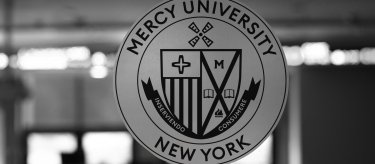
Determination of Attempted and Earned Credits for Satisfactory Academic Progress (SAP)
Determination of Attempted and Earned Credits for SAP
The University includes all courses attempted at Mercy University plus course work accepted as transfer credit towards the student's declared major in the quantitative measurement in determining successful SAP. This also includes courses taken via a Consortium Agreement.
Earned hours include all courses which a passing grade was received (A, B, C, D).
All withdrawn courses (W, FW) and failed courses (F) are counted as unearned hours in the calculation.
Repeated courses are counted in the attempted hours and are taken into consideration for the maximum allowed hours for completion toward the degree.
- Remedial Courses
Since remedial courses and the remedial component of developmental and compensatory courses do not carry degree credit, enrollment in these courses will not result in the inclusion of the non-credit portion as cumulative attempted credits. - Withdrawals
Withdrawals as part of the program adjustment period will not be included as cumulative attempted credits. Withdrawals that are recorded on a student's permanent record will be included as cumulative attempted credits and will have an adverse effect on a student's capability to meet the appropriate standard. NOTE: Retroactive "non-punitive" administrative withdrawal activity may result in the requirement for the student to repay any assistance received as a result of the student's enrollment at the time of receipt of the student assistance funds. - Incomplete Grades
Courses with incomplete grades are included as cumulative attempted credits. However, these courses cannot be used as credits earned toward the degree since successful completion is the criterion for positive credit accumulation. Incomplete grades will be treated as an F when calculating a student's cumulative GPA for the purpose of determining whether a student has maintained the qualitative standards of satisfactory academic progress. If the student fails to meet the appropriate standard for credit accumulation due to the lack of successful completion grades for these courses, the recording of successful completion grades within a term which brings the accumulated credit level to the appropriate standard will restore eligibility for the term and subsequent terms within the academic year. - Repeated Courses
Successfully completed courses can generally be accepted toward degree requirements once. However, each time a student attempts a course, it is included as part of the cumulative attempted credit record. Therefore, repeated courses, regardless of the prior grade, reduce a student's capacity to meet the appropriate credit accumulation standard.
Treatment of Non-Standard Situations
- Readmitted Students
Upon readmission after at least a one-year period of non-reenrollment, the student will receive assistance for the terms in the academic year of readmission and will be evaluated for future eligibility at the end of the spring term against the appropriate standard for the degree program for which the student is enrolled. The student's previous academic history will be included as part of the calculation. If a student is readmitted after less than one year of non-enrollment, the academic record will be evaluated for satisfactory academic progress under these standards as the record stood at the end of the last term of attendance. - Transfer Students
Transfer students shall have their status initialized for purposes of satisfactory academic progress measurement by using the number of credits determined to be acceptable toward the degree as both the students' cumulative attempted credits and cumulative earned credits. - Second Degree Students
Students enrolling for a second degree, either baccalaureate or graduate, shall have their status initialized for purposes of satisfactory academic progress measurement by using the number of credits determined to be acceptable toward the degree as both the students' cumulative attempted credits and cumulative earned credits. - Change of Major or Degree
A student that changes majors within the same degree must complete the program within the maximum time frame allowed for the new program. Students must be mindful not to exceed the 150 percent maximum time frame when changing majors.
